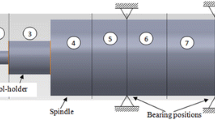Abstract
The concept of directional factor for chatter stability analysis has been used from a long time ago. The analysis of its evolution for different feed directions in milling processes provides a good way of selecting the best cutting conditions. For very stable cutting directions, corresponding to very low directional factors, the single frequency analysis gives unacceptable results and multi-frequency, or alternative solutions as semi-discretisation must be used. It is found also that the period doubling lobes extend at both sides of the tooth pass frequency equivalent to twice the natural frequency. In these cases, helix angle has a very important effect on the stability. For end milling processes, where the mill axial pitch can be of the order of the stable limit depth of cut, a very stable situation is found except in those areas corresponding to period doubling, where instability islands are found. Besides, a graphical construction for accurate estimation of the stable limit depth of cut and starting rotational speed of the period doubling lobes is proposed.
Similar content being viewed by others
References
Tobias SA, Fiswick W (1958) Theory of regenerative machine tool chatter. The Engineer, London
Tlusty J, Polacek M (1957) Beispiele der behandlung der selbsterregten Schwingung der Werkzeugmaschinen FoKoMa. Hanser Verlag, Munich
Merrit H (1965) Theory of self-excited machine tool chatter. Transactions of the ASME, Journal of Engineering for Industry 87:447–454
Opitz H (1969) Investigation and calculation of the chatter behavior of lathes and milling machines. CIRP Ann 18:335–342
Altintas Y, Weck M (2004) Chatter stability of metal cutting and grinding. CIRP Ann 53:619–642
Altintas Y, Budak E (1995) Analytical prediction of stability lobes in milling. CIRP Ann 44:357–362
Budak E, Altintas Y (1998) Analytical Prediction of Chatter Stability Conditions for Multidegree of Freedom Systems in Milling. Part I: General Formulation, Part II: Application of the General formulation to Common Milling Systems. Transactions of the ASME, Journal of Engineering for Industry 120:22–36
Davies M, Pratt JR, Dutterer BS, Burns TJ (2000) The stability of low radial immersion milling. CIRP Ann 49:37–40
Insperger T., Stépán G., (2000) Stability of High Speed Milling. In Proceedings of the ASME International Engineering Congress and Exposition, Orlando, Florida, pp. 119-123
Insperger T, Stépán G (2004) Updated semi-discretization method for periodic delay-differential equations with discrete delay. International Journal of Numerical Methods in Engineering 61:117–141
Bayly PV, Halley JE, Mann BP, Davies MA (2003) Stability of interrupted cutting by temporal finite element analysis. International Journal of Manufacturing Science and Engineering 125:220–225
Merdol SD, Altintas Y (2004) Multi frequency solution of chatter stability for low immersion milling. J Manuf Sci Eng 126:459–466
Zatarain M, Muñoa J, Peigné G, Insperger T (2006) Analysis of the influence of mill helix angle on chatter stability. CIRP Ann 55(1):365–368
Insperger T, Muñoa J, Zatarain M, Peigné G (2006) Unstable Islands in the Stability Chart of Milling Processes Due to the Helix Angle. CIRP 2nd International Conference on High Performance Cutting, Vancouver, Canada, pp 12–13
Author information
Authors and Affiliations
Corresponding author
Rights and permissions
About this article
Cite this article
Zatarain, M., Bediaga, I., Muñoa, J. et al. Analysis of directional factors in milling: importance of multi-frequency calculation and of the inclusion of the effect of the helix angle. Int J Adv Manuf Technol 47, 535–542 (2010). https://doi.org/10.1007/s00170-009-2230-5
Received:
Accepted:
Published:
Issue Date:
DOI: https://doi.org/10.1007/s00170-009-2230-5



